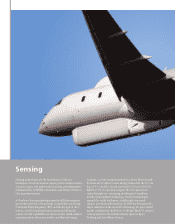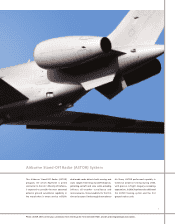Raytheon 2006 Annual Report Download - page 13
Download and view the complete annual report
Please find page 13 of the 2006 Raytheon annual report below. You can navigate through the pages in the report by either clicking on the pages listed below, or by using the keyword search tool below to find specific information within the annual report.-
 1
1 -
 2
2 -
 3
3 -
 4
4 -
 5
5 -
 6
6 -
 7
7 -
 8
8 -
 9
9 -
 10
10 -
 11
11 -
 12
12 -
 13
13 -
 14
14 -
 15
15 -
 16
16 -
 17
17 -
 18
18 -
 19
19 -
 20
20 -
 21
21 -
 22
22 -
 23
23 -
 24
24 -
 25
25 -
 26
26 -
 27
27 -
 28
28 -
 29
29 -
 30
30 -
 31
31 -
 32
32 -
 33
33 -
 34
34 -
 35
35 -
 36
36 -
 37
37 -
 38
38 -
 39
39 -
 40
40 -
 41
41 -
 42
42 -
 43
43 -
 44
44 -
 45
45 -
 46
46 -
 47
47 -
 48
48 -
 49
49 -
 50
50 -
 51
51 -
 52
52 -
 53
53 -
 54
54 -
 55
55 -
 56
56 -
 57
57 -
 58
58 -
 59
59 -
 60
60 -
 61
61 -
 62
62 -
 63
63 -
 64
64 -
 65
65 -
 66
66 -
 67
67 -
 68
68 -
 69
69 -
 70
70 -
 71
71 -
 72
72 -
 73
73 -
 74
74 -
 75
75 -
 76
76 -
 77
77 -
 78
78 -
 79
79 -
 80
80 -
 81
81 -
 82
82 -
 83
83 -
 84
84 -
 85
85 -
 86
86 -
 87
87 -
 88
88 -
 89
89 -
 90
90 -
 91
91 -
 92
92 -
 93
93 -
 94
94 -
 95
95 -
 96
96 -
 97
97 -
 98
98 -
 99
99 -
 100
100 -
 101
101 -
 102
102 -
 103
103 -
 104
104 -
 105
105 -
 106
106 -
 107
107 -
 108
108 -
 109
109 -
 110
110 -
 111
111 -
 112
112 -
 113
113 -
 114
114 -
 115
115 -
 116
116 -
 117
117 -
 118
118 -
 119
119 -
 120
120 -
 121
121 -
 122
122 -
 123
123 -
 124
124 -
 125
125 -
 126
126 -
 127
127 -
 128
128 -
 129
129 -
 130
130 -
 131
131 -
 132
132 -
 133
133 -
 134
134 -
 135
135 -
 136
136
 |
 |

1111
Exoatmospheric Kill Vehicle (EKV)
Photo: Space Operations facility at Raytheon Missile Systems
The Exoatmospheric Kill Vehicle (EKV) was
one of two Raytheon components that played
key roles in the hit-to-kill destruction of a
ballistic missile target in last year’s test of
the Missile Defense Agency’s Ground-based
Midcourse Defense (GMD) system. The
EKV intercepted a ballistic missile target
in space over the eastern Pacific Ocean.
The test marked the first launch from
an operational GMD site and demonstrated
the EKV’s ability to successfully detect, track,
discriminate and destroy a target in space.
The other Raytheon component, an
Upgraded Early Warning Radar (UEWR)
system at Beale Air Force Base in California,
supported the intercept by successfully
providing information to the GMD Ground
Fire Control. The GMD system is designed
to protect all 50 U.S. states against limited
ballistic missile attack by intercepting long-
range ballistic missiles during the midcourse
or ballistic phase of their fl ight, before reentry
into the earth’s atmosphere. GMD interceptors
are in silos today in Fort Greely, Alaska, and
Vandenberg Air Force Base, California.
